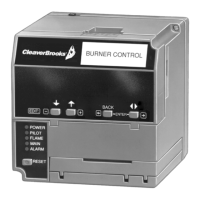CB780/CB784 RELAY MODULES
32-00207—01 16
Fig. 13. Data ControlBus™ mounting.
Remote Mounting of Keyboard
Display Module
1. The Keyboard Display Module can be mounted
either on the face of a panel door or on other remote
locations; see Fig. 15.
2. When mounting the Keyboard Display Module on
the face of a door panel, closely follow these instruc-
tions:
a. Select the location on the door panel for flush
mounting. Pay attention to the insertion dimen-
sion of the two Keyboard Display Module screws,
two interlocking ears and the two plug-in con-
nectors to allow for sufficient clearance, 1/4 inch
minimum inward from the surface of the door
panel.
b. Use the Keyboard Display Module as a template;
see Fig. 28. Mark the two screw locations, two
interlocking ear locations and two plug-in con-
nector locations. Drill the pilot holes for the
mounting screws. Provide for two holes on the
door panel for the interlocking ears and plug-in
connector holes.
c. Mount the Keyboard Display Module securing
the two no. 4 screws.
3. A second Keyboard Display Module or a Data
ControlBus™ Module must be installed on the
CB780/CB784. Connections from the module to the
remote display are completed following wiring
shown in Fig.8, 9, 10.
Installing Plug-In Flame Signal
Amplifier
1. Disconnect power supply before beginning installa-
tion to prevent electrical shock and equipment dam-
age. More than one disconnect may be involved.
2. Align the amplifier circuit board edge connector with
the keyed receptacle on the CB780/CB784. Verify
the amplifier nameplate faces away from the Relay
Module, see Fig. 16.
3. Push in the amplifier until the circuit board is fully
inserted into the receptacle and then push the
amplifier toward the CB780/CB784 retaining clasp.
4. Verify the amplifier is firmly in place.
5. Perform all required checkout tests.
Installing the Flame Detector
NOTE: Table 2 lists the flame detection systems avail-
able for use with the CB780/CB784. Make sure
the correct combination of amplifier and flame
detector(s) is used.
Proper flame detector installation is the basis of a safe
and reliable flame safeguard installation. Refer to the
instructions packed with the flame detector and the
equipment manufacturer instructions; see Fig. 17.
Keep the flame signal leadwires as short as possible from
the flame detector to the wiring subbase. Capacitance
increases with leadwire length, reducing the signal
strength. The maximum permissible leadwire length
depends on the type of flame detector, leadwire and
conduit. The ultimate limiting factor in the flame detector
leadwire is the flame signal; see Table 9.
Fig. 14. Remote mounting of Keyboard Display Module.
Fig. 15. Flame signal amplifier mounting.

